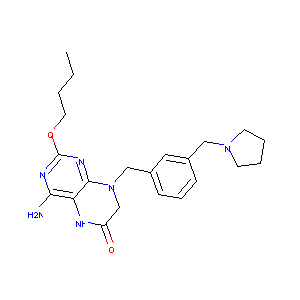| DOT Name |
DOT ID |
UniProt ID |
Mode of Action |
REF |
|
Catalase (CAT)
|
OTHEBX9R
|
CATA_HUMAN
|
Increases Expression
|
[7] |
|
Transcription factor Sp1 (SP1)
|
OTISPT4X
|
SP1_HUMAN
|
Decreases Expression
|
[7] |
|
Glutathione S-transferase P (GSTP1)
|
OTLP0A0Y
|
GSTP1_HUMAN
|
Decreases Expression
|
[7] |
|
Tumor necrosis factor receptor superfamily member 6 (FAS)
|
OTP9XG86
|
TNR6_HUMAN
|
Increases Expression
|
[7] |
|
Caspase-3 (CASP3)
|
OTIJRBE7
|
CASP3_HUMAN
|
Increases Activity
|
[7] |
|
Serine/threonine-protein kinase Chk1 (CHEK1)
|
OTTTI622
|
CHK1_HUMAN
|
Increases Phosphorylation
|
[11] |
|
Ubiquitin-like protein ATG12 (ATG12)
|
OTJRO09Y
|
ATG12_HUMAN
|
Increases Expression
|
[12] |
|
Apoptosis-inducing factor 1, mitochondrial (AIFM1)
|
OTKPWB7Q
|
AIFM1_HUMAN
|
Affects Localization
|
[13] |
|
Serine/threonine-protein kinase Chk2 (CHEK2)
|
OT8ZPCNS
|
CHK2_HUMAN
|
Increases Phosphorylation
|
[11] |
|
Metalloproteinase inhibitor 1 (TIMP1)
|
OTOXC51H
|
TIMP1_HUMAN
|
Increases Expression
|
[12] |
|
Fibronectin (FN1)
|
OTB5ZN4Q
|
FINC_HUMAN
|
Decreases Expression
|
[12] |
|
Ferritin heavy chain (FTH1)
|
OT6IFS0O
|
FRIH_HUMAN
|
Decreases Expression
|
[12] |
|
Cellular tumor antigen p53 (TP53)
|
OTIE1VH3
|
P53_HUMAN
|
Increases Expression
|
[14] |
|
Poly polymerase 1 (PARP1)
|
OT310QSG
|
PARP1_HUMAN
|
Increases Cleavage
|
[13] |
|
Apoptosis regulator Bcl-2 (BCL2)
|
OT9DVHC0
|
BCL2_HUMAN
|
Decreases Expression
|
[13] |
|
Matrix metalloproteinase-9 (MMP9)
|
OTB2QDAV
|
MMP9_HUMAN
|
Decreases Expression
|
[12] |
|
Replication protein A 32 kDa subunit (RPA2)
|
OTZ54WAF
|
RFA2_HUMAN
|
Increases Phosphorylation
|
[11] |
|
Histone H2AX (H2AX)
|
OT18UX57
|
H2AX_HUMAN
|
Increases Phosphorylation
|
[11] |
|
Desmin (DES)
|
OTI09KBW
|
DESM_HUMAN
|
Decreases Expression
|
[12] |
|
Phospholipid hydroperoxide glutathione peroxidase GPX4 (GPX4)
|
OTRAFFX2
|
GPX4_HUMAN
|
Decreases Activity
|
[12] |
|
Serine/threonine-protein kinase mTOR (MTOR)
|
OTHH8KU7
|
MTOR_HUMAN
|
Decreases Phosphorylation
|
[8] |
|
Caspase-9 (CASP9)
|
OTD4RFFG
|
CASP9_HUMAN
|
Affects Expression
|
[13] |
|
Actin, aortic smooth muscle (ACTA2)
|
OTEDLG8E
|
ACTA_HUMAN
|
Decreases Expression
|
[12] |
|
Apoptosis regulator BAX (BAX)
|
OTAW0V4V
|
BAX_HUMAN
|
Increases Expression
|
[13] |
|
Sequestosome-1 (SQSTM1)
|
OTGY5D5J
|
SQSTM_HUMAN
|
Decreases Expression
|
[12] |
|
Nuclear receptor coactivator 4 (NCOA4)
|
OTRVU0UA
|
NCOA4_HUMAN
|
Decreases Expression
|
[12] |
|
Nuclear factor erythroid 2-related factor 2 (NFE2L2)
|
OT0HENJ5
|
NF2L2_HUMAN
|
Affects Localization
|
[15] |
|
Microtubule-associated proteins 1A/1B light chain 3B (MAP1LC3B)
|
OTUYHB84
|
MLP3B_HUMAN
|
Increases Lipidation
|
[8] |
|
Autophagy protein 5 (ATG5)
|
OT4T5SMS
|
ATG5_HUMAN
|
Increases Expression
|
[12] |
|
DNA dC->dU-editing enzyme APOBEC-3C (APOBEC3C)
|
OTPL0AI1
|
ABC3C_HUMAN
|
Increases Expression
|
[11] |
|
Ubiquitin-like-conjugating enzyme ATG3 (ATG3)
|
OT28VBVK
|
ATG3_HUMAN
|
Increases Expression
|
[12] |
|
Small ribosomal subunit protein uS8 (RPS15A)
|
OT0BUA12
|
RS15A_HUMAN
|
Decreases Response To Substance
|
[9] |
|
Mitochondrial thiamine pyrophosphate carrier (SLC25A19)
|
OT157TY3
|
TPC_HUMAN
|
Decreases Response To Substance
|
[9] |
|
Atypical kinase COQ8A, mitochondrial (COQ8A)
|
OT1ETSA2
|
COQ8A_HUMAN
|
Decreases Response To Substance
|
[9] |
|
Bifunctional methylenetetrahydrofolate dehydrogenase/cyclohydrolase, mitochondrial (MTHFD2)
|
OT1LQSGX
|
MTDC_HUMAN
|
Decreases Response To Substance
|
[9] |
|
Large ribosomal subunit protein uL30 (RPL7)
|
OT4WCQBE
|
RL7_HUMAN
|
Decreases Response To Substance
|
[9] |
|
Glutamate--cysteine ligase regulatory subunit (GCLM)
|
OT6CP234
|
GSH0_HUMAN
|
Decreases Response To Substance
|
[16] |
|
Integrin beta-1 (ITGB1)
|
OT6G1IAR
|
ITB1_HUMAN
|
Increases Response To Substance
|
[9] |
|
CAP-Gly domain-containing linker protein 4 (CLIP4)
|
OT75KVQK
|
CLIP4_HUMAN
|
Increases Response To Substance
|
[9] |
|
Glutathione S-transferase theta-2 (GSTT2)
|
OTANW3TJ
|
GST2_HUMAN
|
Affects Response To Substance
|
[16] |
|
ADP-ribosyl cyclase/cyclic ADP-ribose hydrolase 2 (BST1)
|
OTAV5SE7
|
BST1_HUMAN
|
Increases Response To Substance
|
[9] |
|
Small ribosomal subunit protein eS12 (RPS12)
|
OTBRQ8MS
|
RS12_HUMAN
|
Decreases Response To Substance
|
[9] |
|
Dopamine beta-hydroxylase (DBH)
|
OTC6I2SP
|
DOPO_HUMAN
|
Increases Response To Substance
|
[9] |
|
Glutamate--cysteine ligase catalytic subunit (GCLC)
|
OTESDI4D
|
GSH1_HUMAN
|
Decreases Response To Substance
|
[16] |
|
Nck-associated protein 1 (NCKAP1)
|
OTEZQXXJ
|
NCKP1_HUMAN
|
Increases Response To Substance
|
[9] |
|
Small ribosomal subunit protein eS32 (RPL41)
|
OTFW5IFO
|
RS32_HUMAN
|
Decreases Response To Substance
|
[9] |
|
Translationally-controlled tumor protein (TPT1)
|
OTHMTRJU
|
TCTP_HUMAN
|
Affects Response To Substance
|
[17] |
|
Nascent polypeptide-associated complex subunit alpha (NACA)
|
OTLP1KR3
|
NACA_HUMAN
|
Decreases Response To Substance
|
[9] |
|
Glutathione S-transferase Mu 4 (GSTM4)
|
OTOTF8DU
|
GSTM4_HUMAN
|
Affects Response To Substance
|
[16] |
|
Maleylacetoacetate isomerase (GSTZ1)
|
OTQ43JCE
|
MAAI_HUMAN
|
Affects Response To Substance
|
[16] |
|
Large ribosomal subunit protein eL6 (RPL6)
|
OTRU71O4
|
RL6_HUMAN
|
Decreases Response To Substance
|
[9] |
|
Small ribosomal subunit protein eS6 (RPS6)
|
OTT4D1LN
|
RS6_HUMAN
|
Decreases Response To Substance
|
[9] |
|
Frizzled-7 (FZD7)
|
OTTK3F6E
|
FZD7_HUMAN
|
Increases Response To Substance
|
[9] |
|
Serine/arginine-rich splicing factor 2 (SRSF2)
|
OTVDHO6U
|
SRSF2_HUMAN
|
Decreases Response To Substance
|
[9] |
|
T-complex protein 1 subunit beta (CCT2)
|
OTW1VV4E
|
TCPB_HUMAN
|
Decreases Response To Substance
|
[9] |
|
Glutathione S-transferase 3, mitochondrial (MGST3)
|
OTYK80JA
|
MGST3_HUMAN
|
Affects Response To Substance
|
[16] |
|
Filamin-A (FLNA)
|
OTYZ9JXM
|
FLNA_HUMAN
|
Increases Response To Substance
|
[9] |
| ------------------------------------------------------------------------------------ |
|
|
|
|


